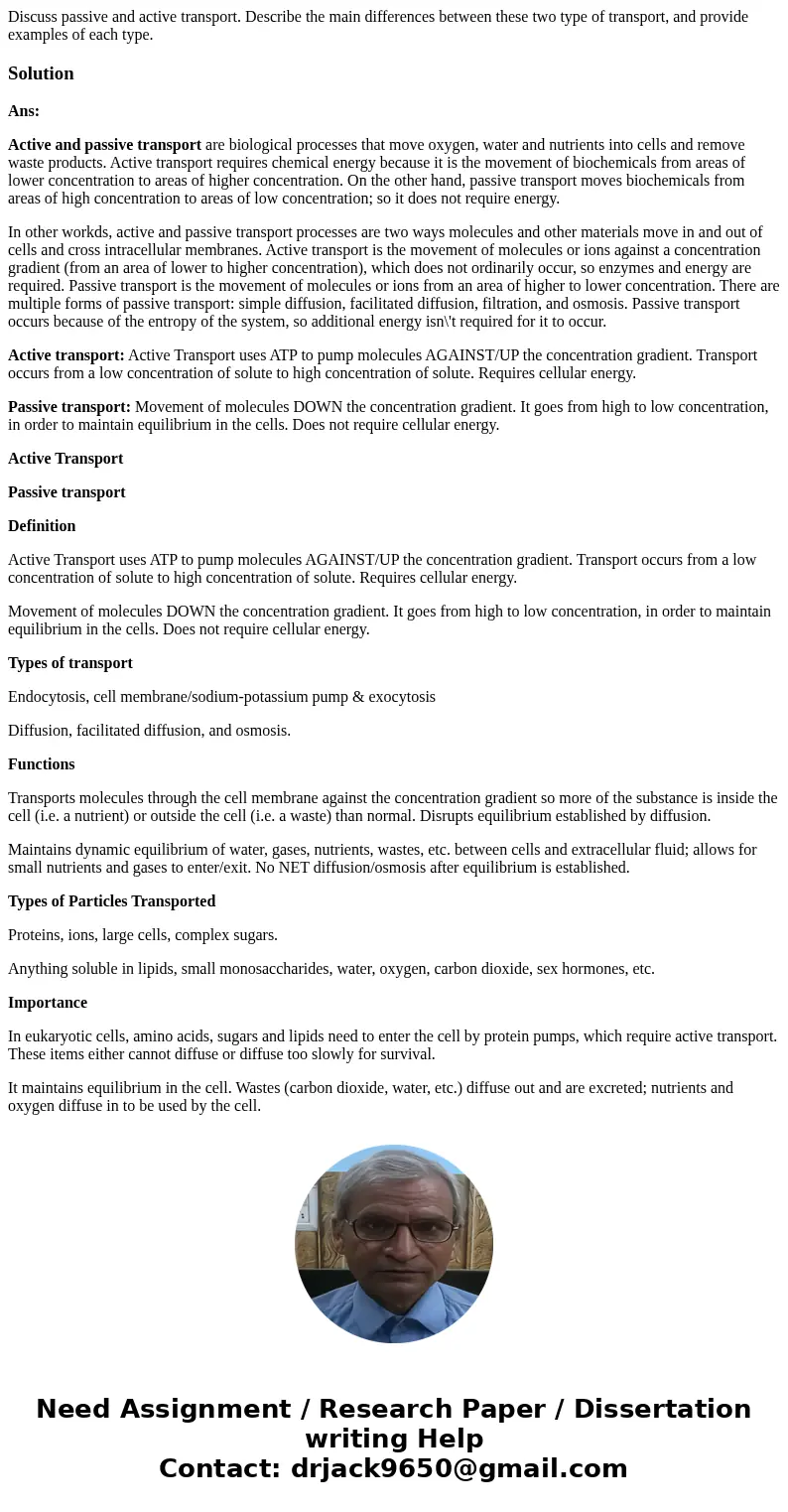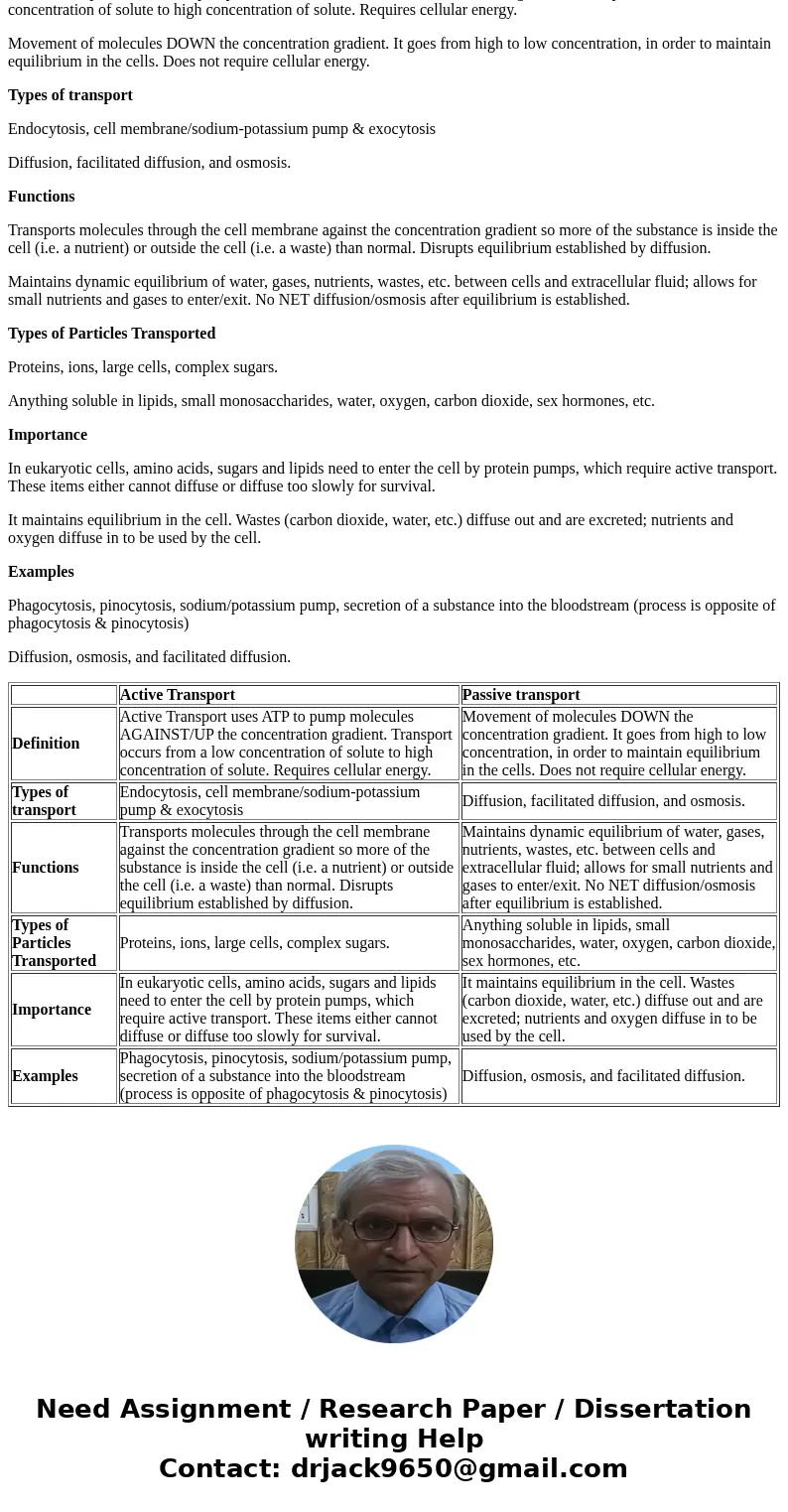Discuss passive and active transport Describe the main diffe
Solution
Ans:
Active and passive transport are biological processes that move oxygen, water and nutrients into cells and remove waste products. Active transport requires chemical energy because it is the movement of biochemicals from areas of lower concentration to areas of higher concentration. On the other hand, passive transport moves biochemicals from areas of high concentration to areas of low concentration; so it does not require energy.
In other workds, active and passive transport processes are two ways molecules and other materials move in and out of cells and cross intracellular membranes. Active transport is the movement of molecules or ions against a concentration gradient (from an area of lower to higher concentration), which does not ordinarily occur, so enzymes and energy are required. Passive transport is the movement of molecules or ions from an area of higher to lower concentration. There are multiple forms of passive transport: simple diffusion, facilitated diffusion, filtration, and osmosis. Passive transport occurs because of the entropy of the system, so additional energy isn\'t required for it to occur.
Active transport: Active Transport uses ATP to pump molecules AGAINST/UP the concentration gradient. Transport occurs from a low concentration of solute to high concentration of solute. Requires cellular energy.
Passive transport: Movement of molecules DOWN the concentration gradient. It goes from high to low concentration, in order to maintain equilibrium in the cells. Does not require cellular energy.
Active Transport
Passive transport
Definition
Active Transport uses ATP to pump molecules AGAINST/UP the concentration gradient. Transport occurs from a low concentration of solute to high concentration of solute. Requires cellular energy.
Movement of molecules DOWN the concentration gradient. It goes from high to low concentration, in order to maintain equilibrium in the cells. Does not require cellular energy.
Types of transport
Endocytosis, cell membrane/sodium-potassium pump & exocytosis
Diffusion, facilitated diffusion, and osmosis.
Functions
Transports molecules through the cell membrane against the concentration gradient so more of the substance is inside the cell (i.e. a nutrient) or outside the cell (i.e. a waste) than normal. Disrupts equilibrium established by diffusion.
Maintains dynamic equilibrium of water, gases, nutrients, wastes, etc. between cells and extracellular fluid; allows for small nutrients and gases to enter/exit. No NET diffusion/osmosis after equilibrium is established.
Types of Particles Transported
Proteins, ions, large cells, complex sugars.
Anything soluble in lipids, small monosaccharides, water, oxygen, carbon dioxide, sex hormones, etc.
Importance
In eukaryotic cells, amino acids, sugars and lipids need to enter the cell by protein pumps, which require active transport. These items either cannot diffuse or diffuse too slowly for survival.
It maintains equilibrium in the cell. Wastes (carbon dioxide, water, etc.) diffuse out and are excreted; nutrients and oxygen diffuse in to be used by the cell.
Examples
Phagocytosis, pinocytosis, sodium/potassium pump, secretion of a substance into the bloodstream (process is opposite of phagocytosis & pinocytosis)
Diffusion, osmosis, and facilitated diffusion.
| Active Transport | Passive transport | |
| Definition | Active Transport uses ATP to pump molecules AGAINST/UP the concentration gradient. Transport occurs from a low concentration of solute to high concentration of solute. Requires cellular energy. | Movement of molecules DOWN the concentration gradient. It goes from high to low concentration, in order to maintain equilibrium in the cells. Does not require cellular energy. |
| Types of transport | Endocytosis, cell membrane/sodium-potassium pump & exocytosis | Diffusion, facilitated diffusion, and osmosis. |
| Functions | Transports molecules through the cell membrane against the concentration gradient so more of the substance is inside the cell (i.e. a nutrient) or outside the cell (i.e. a waste) than normal. Disrupts equilibrium established by diffusion. | Maintains dynamic equilibrium of water, gases, nutrients, wastes, etc. between cells and extracellular fluid; allows for small nutrients and gases to enter/exit. No NET diffusion/osmosis after equilibrium is established. |
| Types of Particles Transported | Proteins, ions, large cells, complex sugars. | Anything soluble in lipids, small monosaccharides, water, oxygen, carbon dioxide, sex hormones, etc. |
| Importance | In eukaryotic cells, amino acids, sugars and lipids need to enter the cell by protein pumps, which require active transport. These items either cannot diffuse or diffuse too slowly for survival. | It maintains equilibrium in the cell. Wastes (carbon dioxide, water, etc.) diffuse out and are excreted; nutrients and oxygen diffuse in to be used by the cell. |
| Examples | Phagocytosis, pinocytosis, sodium/potassium pump, secretion of a substance into the bloodstream (process is opposite of phagocytosis & pinocytosis) | Diffusion, osmosis, and facilitated diffusion. |


 Homework Sourse
Homework Sourse